New York City’s Largest Group of Drivers is Being Left Out of the Electric Vehicle Conversation

Gov. Hochul drives an electric vehicle (photo: Governor's Office)
A recently-launched pilot offers Uber, Lyft, and other for-hire-vehicle drivers the opportunity to trade their gas-powered vehicle in for an electric Tesla. An experienced, high-earning Uber driver, Angelis, jumped at the opportunity – but within a week returned the Tesla for a traditional black SUV. He loved driving the car and said his customers raved about it. But as a resident of the Bronx, it was not feasible for him to keep it — going electric meant he had to drive 35 minutes twice a day to a charging station and wait there for a charger to open. Because he drives so much, he spent almost as much on charging as he would on gas. So Angelis will be back in a gas-powered SUV until New York is ready to support his transition to an electric vehicle.
The news is filled with exciting investments from Washington and Albany in New York City’s electric vehicle future, but this effort is inadvertently ignoring the most critical subset of drivers who can have the largest impact on our city’s environmental footprint. For-hire-vehicle (FHV) drivers, like those on the Uber and Lyft platforms, outnumber yellow cab drivers 8 to 1.
New York State received federal backing for 60,000 new highway chargers, as well as an expanded supercharger network in Manhattan or near the city’s airports. This approach is geared towards leisure and commuting drivers, leaving FHV drivers in the dust.
FHVs have become a central part of the city’s transportation system. Among other benefits, FHVs supplement public transportation systems in the outer boroughs where buses and trains run less frequently or not at all. Certainly, the last thing New York City needs is more vehicles on the road — encouraging leisure or personal-use electric vehicles and charging support alone will only increase congestion.
As CEO of Voyager Global Mobility, the leading provider of for-hire vehicles in New York City, I work to support thousands of drivers, providing them with safe, up-to-date vehicles and support. I hear directly from drivers every day, and it has become clear that the key is to convert existing FHV-licensed vehicles to EVs rather than clogging our streets with new vehicles as Uber and Lyft aim to achieve their EV commitments.
There are 90,000 FHV licenses operating in the five boroughs of New York City, providing in sum an average of 600,000 rides a day. Luckily, New York is the most regulated city for the for-hire-vehicle industry in the world, which means drivers pass more rigorous screening, vehicles are inspected more often, and overall, FHVs are safe and reliable. Due to these extremely high standards and the continued need for professional drivers, many of these 90,000 New Yorkers have turned driving into a career, and their cars are their keys to a steady income and a foothold on the economic ladder.
The overwhelming majority of FHV drivers use gas-powered cars — only about 615 FHVs in all of New York City are EVs. It’s not that the mobility industry doesn’t care about the environment or resists EVs. The challenge is that the charging system does not support an equitable EV transition for drivers.
We cannot expect these hard-working New Yorkers to trade in their current vehicles — their most important revenue-generating asset — for EVs that will require inconvenient and expensive charging. They cannot waste time that could be used to make money to drive across the boroughs or along the highway to wait in long lines for a full charge (which already takes 40 minutes on its own).
Despite being home to 40% of New York City’s FHV drivers, Queens has just 16% of the city’s chargers. Manhattan is home to just 8% of New York’s TLC-licensed drivers, but the disproportionate concentration of chargers there primarily benefit residents that own individual electric vehicles, not the working-class drivers of the outer boroughs who rely on this infrastructure for their livelihoods.
New EV charging stations need to be concentrated in the outer boroughs, where FHV drivers actually live. FHV electric vehicles have to charge three times more frequently than personal cars, which are used much less frequently for fewer miles at a time.
As it stands, the city’s public charging network is tight and poorly distributed throughout the five boroughs. The entire city has roughly 2,000 public chargers (of which only about 120 are fast charging) for its nearly 6,000 EVs on the road, and 56% of those chargers are concentrated in Manhattan. Vehicle subscription companies, like Voyager Global Mobility, can pinpoint exactly which neighborhoods have high numbers of drivers. There are certain zip codes in Queens with 100+ clients renting for-hire-vehicles just from us — those are the areas where we need to focus our expanded EV charging infrastructure efforts.
Further, we need to ensure that charging is affordable outside of the congested areas of Manhattan. Recently, the TLC announced discounts at NYC Department of Transportation charging hubs, which is extremely helpful. However, it only covers two hubs, neither of which are in the Bronx or Brooklyn.
We need to acknowledge that this city is not set up for anywhere close to 90,000 gasoline cars to be converted to EVs. If not now, when? EV investments must focus on the needs of FHV drivers. We’re ready for solutions and we invite the city, the state, and other partners to come along for the ride.
***
Sam Jurkowicz is a former Uber driver and the CEO of Voyager Global Mobility, the leading provider of vehicles and services for NYC’s growing for-hire-vehicle mobility needs.
***
Have an op-ed idea or submission for Gotham Gazette? Email This email address is being protected from spambots. You need JavaScript enabled to view it.
To Truly Pursue Equity in Marijuana Rollout, Cannabis NYC Needs a Makeover
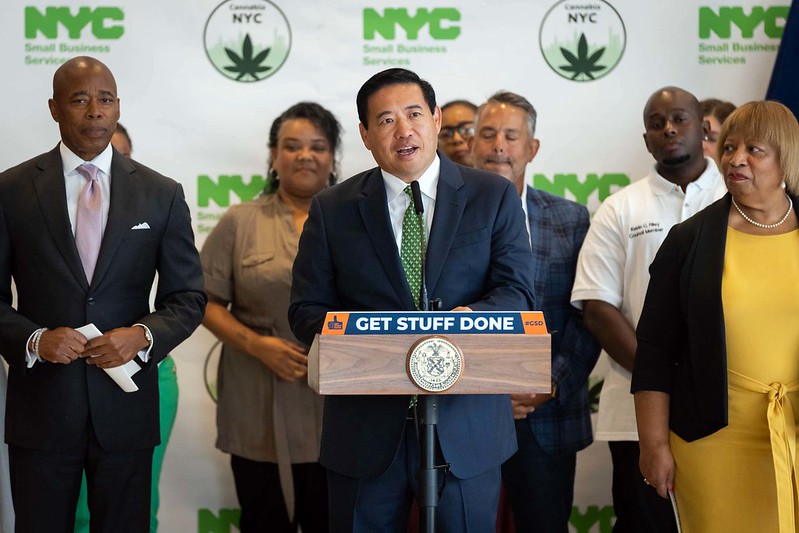
Announcing 'Cannabis NYC' (photo: Ed Reed/Mayoral Photography Office)
It’s no secret that the War on Drugs has disproportionately impacted people of color in the United States, leading to the scourge of mass incarceration. In 2010, the ACLU released an analysis on cannabis convictions, showing that Black people in New York state were 4.5 times more likely to get arrested for possession of cannabis than white people even though both groups use it at the same rate. Ten years later, this phenomenon hasn’t changed. In 2020, the NYPD’s crime statistics data reported that people of color in NYC made up 94% of arrests and summonses issued for low level cannabis violations.
It has been over a year and a half since cannabis was legalized in New York. Heralded as the most equitable cannabis legalization effort in the United States, the Marijuana Regulation & Taxation Act (MRTA) focuses on groups that were impacted the most by cannabis prohibition – namely black and brown communities. However, NYC’s program, Cannabis NYC, has not invested nearly enough into communities that have been hurt the most by cannabis prohibition. As New York state implements its recreational cannabis licensing process with the first 36 licenses, and NYC provides a meager $4.8 million investment through its program Cannabis NYC, we must ask ourselves: is this really the best we can do?
In theory, New York state has instituted impressive measures to uplift social equity entrepreneurs, or individuals with prior cannabis-related convictions seeking to open a recreational cannabis business. Some of these initiatives include setting aside 50% of licenses for social equity entrepreneurs to open recreational dispensaries and a $200 million investment fund that will underwrite costs associated with leasing retail spaces and loan assistance. Despite the support on paper, the administration is moving too slowly in practice. The aforementioned retail spaces have not yet been secured and the fund has not raised the promised $150 million in seed funding. With Governor Hochul’s announcement that only 36 legal cannabis dispensaries will be in operation by the end of the year, there is reason to worry about how social equity entrepreneurs will be supported in this disorganized plan.
On the city side, there have been insufficient investments in social equity entrepreneurs. The Adams administration created and tasked Cannabis NYC with providing services including license application assistance, outreach to communities that are eligible to apply for social equity licenses, and workforce development training for the cannabis sector. Even with these minimal responsibilities, Cannabis NYC barely fits the bill. Since Cannabis NYC was only established three months ago, most of the application support was falling on the shoulders of nonprofits and law firms, sometimes costing individuals up to $10,000 in fees.
Additionally, cannabis businesses are a costly endeavor with a $2,000 application fee for a recreational license and high-cost barrier to enter the industry. Start-up costs for retailers can range between $250,000 - $750,000. The Drug Policy Alliance found that in 2019, the city spent almost $100 million alone on policing drug arrests and violations. As reparations for these egregious oppressive measures, Cannabis NYC must expand its supportive services to provide financial assistance to social equity entrepreneurs to cover the recreational cannabis license fee of $2,000
and underwrite a fraction of the start-up fees when the state inevitably moves too slowly to provide assistance. Cannabis NYC must also bolster their application assistance for all New Yorkers seeking their services.
The recent increase in crime may make New Yorkers less sympathetic toward those with prior convictions, leading them to object to additional supportive measures. In a recent poll, 70% of New Yorkers reported concern about feeling less safe since the pandemic due to increased crime rates. However, research has shown that access to employment is the most important factor in reducing recidivism. Even for individuals who do not support cannabis usage, an investment in communities with past convictions will keep them out of the cycle of crime and the prison system, thereby reducing crime rates across the city.
The NYC Comptroller office projected that revenue from cannabis sales in NYC could reach as much as $336 million per year. In a city where the operating budget is $101 billion, this may seem like a drop in the bucket. However, when put into perspective, this amount shows how much NYC will gain from the cannabis industry, while investing just over 1% of projected revenues in social equity entrepreneurs who have been harmed by the city’s criminalization of cannabis. As reparations for the damages that cannabis prohibition ravaged upon Black and Brown communities in NYC, the mayoral administration must ensure social equity entrepreneurs make their mark in this highly profitable industry. One small step is by increasing financial support to social equity entrepreneurs through underwriting their start up business costs and covering the $2,000 retail dispensary license application fee.
***
Arielle Kaye is an MPA student at NYU specializing in International Development Policy & Management.
***
Have an op-ed idea or submission for Gotham Gazette? Email This email address is being protected from spambots. You need JavaScript enabled to view it.
Reason to be Thankful This Holiday Season: New Law Empowers Sexual Assault Survivors
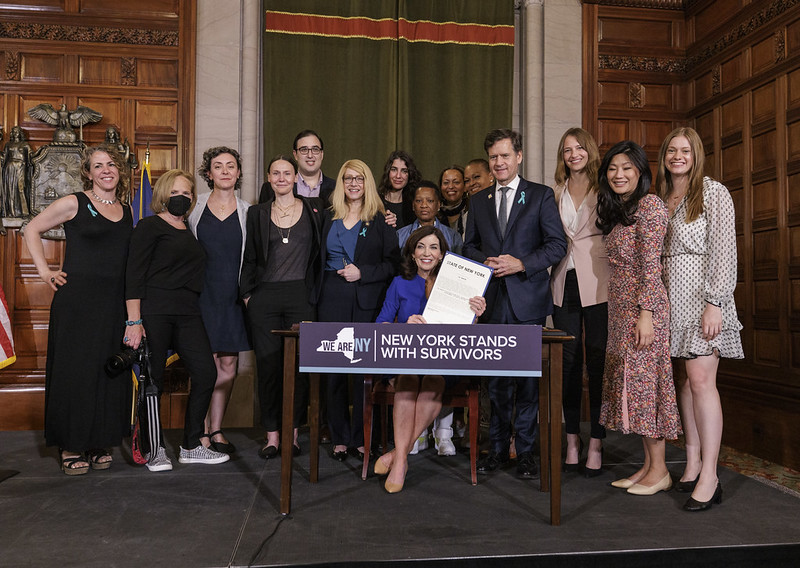
Gov. Hochul signs the Adult Survivors Act (photo: Mike Groll/Governor's Office)
On Thanksgiving, survivors of sexual abuse in New York had something to be truly thankful for. November 24 marked the opening of a one-year period when, under a new law, survivors can file a civil claim against the person who abused them and any institutions that enabled the abuse, no matter how long ago the abuse happened.
This law, the New York Adult Survivors Act (ASA), presents a watershed moment for survivors; it invites and empowers them to reclaim their narratives, end their silence, and hold those who harmed them accountable.
The ASA was born of the recognition that for too long, survivors of sexual abuse were either disbelieved, shamed, or blamed for the abuse and left with little support to recover from the trauma left in its wake. After all, until 1984 it was legal in New York for a husband to rape his wife. And sexual harassment was not even considered a violation of federal civil rights law until 1986. Even once the laws became more protective of survivors, historically short statute of limitations periods meant that by the time survivors were able to speak their truth, it was often too late to sue the abuser. In reviving expired claims, the ASA also revives survivors’ chances for a measure of justice and acknowledges the reality that processing sexual trauma takes time.
Ending silence, secrecy, and shame around abuse is why laws like the ASA, the Child Victims Act before it, and the anti-SLAPP law New York passed in 2020, are so important. SLAPP lawsuits (or Strategic Lawsuits Against Public Participation) have long been used by abusers to torment and silence survivors. Formally named in the 1980s and in use well before that, a SLAPP suit may look like an ordinary claim for defamation, nuisance, or invasion of privacy but its purpose is to intimidate and muzzle the person on the other side. Abusers leverage SLAPP lawsuits to tie up survivors in lengthy legal proceedings in an attempt to drain them of their financial and emotional resources while fighting these baseless claims.
This tool was famously used by Johnny Depp against Amber Heard to punish her for publicly telling her story of intimate partner violence in the Washington Post, leaving her silenced and impoverished in the end. The publicity surrounding that case has undoubtedly had a chilling effect on survivors considering coming forward to speak out about the abuse they suffered, especially if their abuser is famous, powerful, or rich.
The SLAPP suit is also the tool that was wielded against me (Grace) by my ex-husband, who sued me for defamation after I spoke out on my podcast about abuse in the entertainment industry and the challenges facing victims in the justice system. But thanks to New York’s anti-SLAPP law, my story has a happier ending than Amber’s: earlier this month, a court threw out the lawsuit against me and ordered my ex-husband to pay the attorney fees and costs I incurred while defending myself.
For too long, short statutes of limitations for filing abuse claims and the threat of SLAPP lawsuits conspired to keep survivors quiet. And that silence only benefited abusers, allowing many to suffer no consequences and go on to abuse others. But taken together, New York’s anti-SLAPP statute and the one-year Adult Survivors Act revival period create the opportunity for a full-throated telling of survivors’ stories to fill the courts with accountability as its final chapter. And that is something to be thankful for.
***
Grace Aki is an actor, playwright, and comedian in New York. Laura Edidin is Of Counsel at Wigdor LLP, a former sex crimes prosecutor, and domestic violence victim advocate. On Twitter @itsgraceaki & @WigdorLaw.
***
Have an op-ed idea or submission for Gotham Gazette? Email This email address is being protected from spambots. You need JavaScript enabled to view it.
New York Universities, It’s Time to Tear Down That Wall
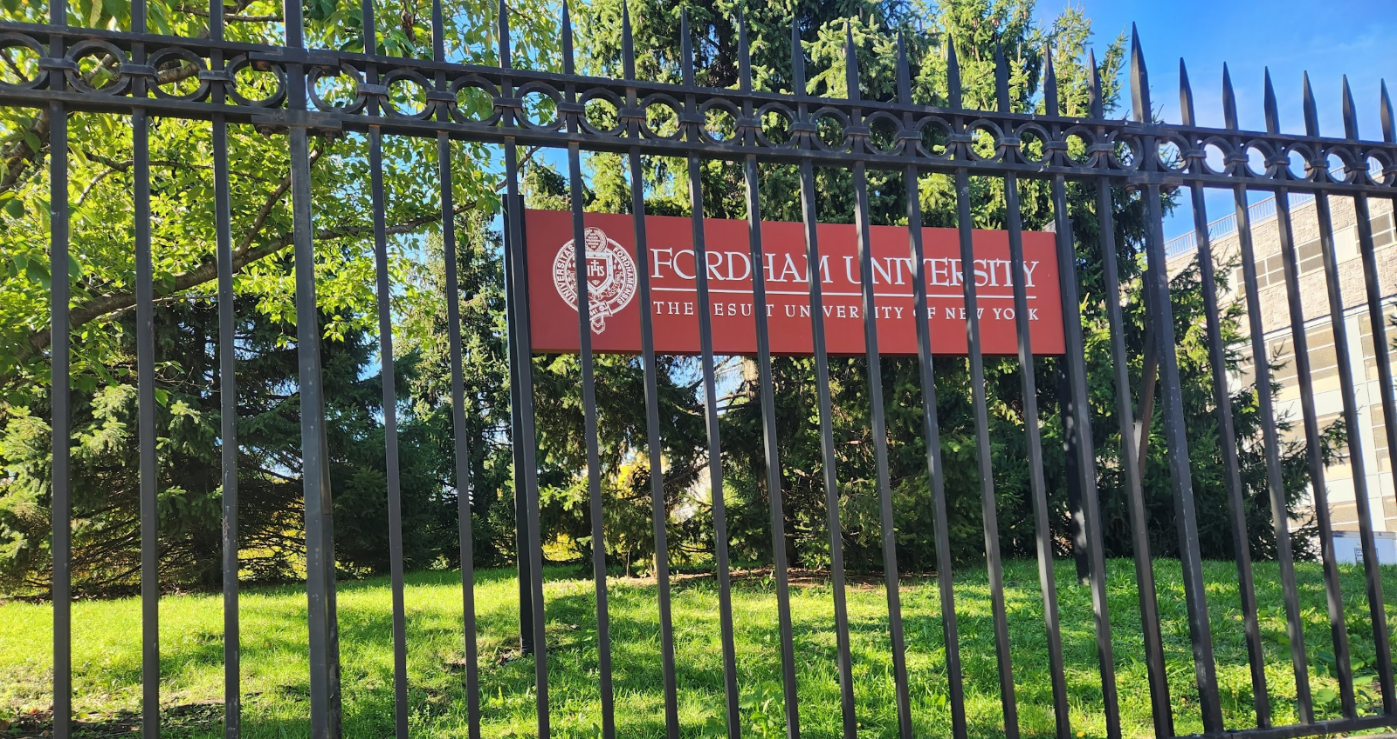
Fordham University behind the wall (photo: Brian Martindale)
New York universities are walling people out. Major private institutions across the city are surrounded by gates, but not because they are in the most dangerous neighborhoods. Rather, it appears that largely white student bodies are being walled off from their surrounding communities because of unfounded fear of racial others.
Columbia University, in a neighborhood adjacent to Central Harlem, is blockaded on every side with a security force keeping watch on all who enter its narrow gates. St. John’s University, in Queens’ Hillcrest neighborhood, is peppered with turnstiles, gated parking lots, and signs marking it as “Private Property.” Fordham University’s Rose Hill campus in the Bronx is similarly locked-down, separated from the surrounding community by wrought iron and chain link fences, at places with barbed wire and stone walls. The only way in, with few exceptions, is by scanning a school ID past a staffed security booth or full-height turnstiles.
Standing in contrast is New York University, located in Manhattan’s Greenwich Village. NYU is a decidedly urban campus, built into the fabric of the city, with the public Washington Square Park serving as its primary quad.
What makes NYU different? Gut instinct might suggest NYU is in a safer neighborhood so it doesn’t need a gate. But it turns out the universities that believe they need to wall out crime are actually in safer communities. A quick look at crime statistics since 2000 shows that among the four universities, NYU’s precinct has had the highest or second highest number of major felonies every year. The area around Columbia has had half as many major crimes as the area near NYU every year for the last 22. This year, NYU is on pace to have the highest crime again, with 2,045 major felonies as of November 13, compared to 1,869; 1,357; and 720 for Fordham Rose Hill, St. John’s, and Columbia, respectively. If NYU can manage without a wall, the others can as well.
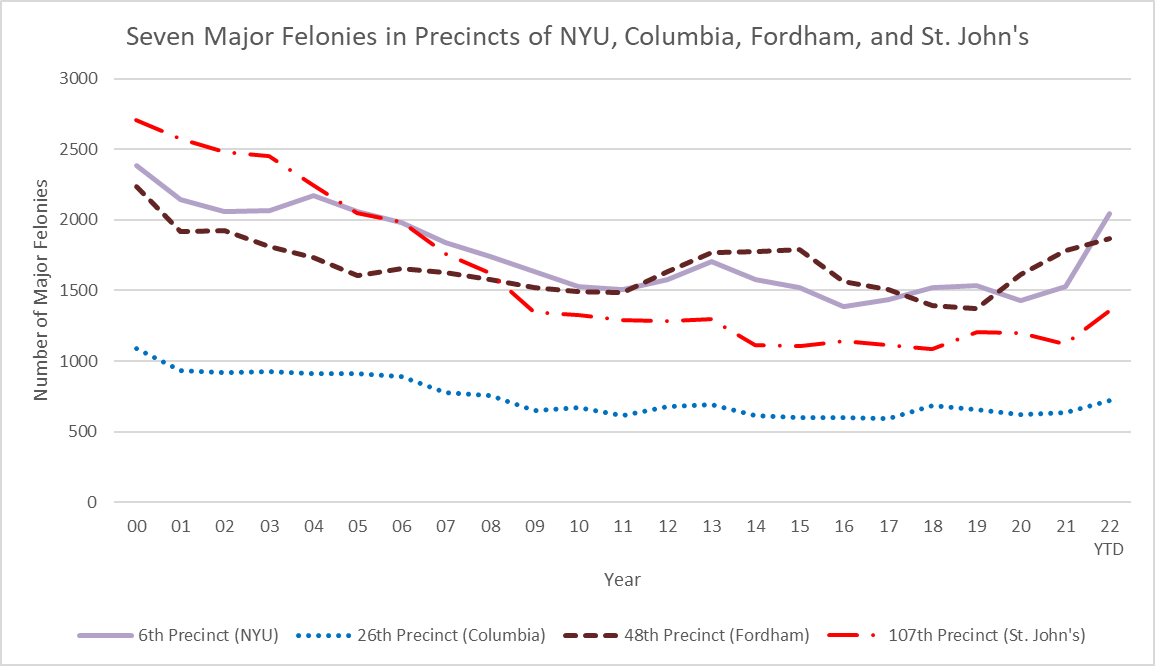
There is, however, a key factor that distinguishes NYU from the three other universities: the racial makeup of the neighborhood. In 2019, Greenwich Village/Soho was 14% Black and Hispanic, while Columbia and Fordham are in neighborhoods that are majority Black and Hispanic. St. John’s is in a neighborhood that is 37% Black or Hispanic and also has a significant Asian population, at 31% of residents.
It is no secret that perceptions of safety are often related to race. A 2001 article by researchers at Florida State University suggests the presence of racial “others” lead to greater fear of crime, and another 2018 article suggests such “white fear” leads to continuing racial segregation. The universities in predominately non-white neighborhoods, though they are safer, appear to be using walls to shut out their neighbors because of this fear.
The shutting-out also shows itself in university enrollment. While 96% of Fordham’s Bronx neighborhood is Black or Hispanic, only 18% of its Bronx campus students were Black or Hispanic in 2020. Columbia had a mere 13% Black or Hispanic population at its Morningside Heights campus in 2020 compared with 52% in the neighborhood. St. John’s Queens campus is closer, with 31% Black or Hispanic students compared to 37% in the neighborhood, but Asian representation is only 16% compared with 31% of neighborhood residents.
These disparities are significant. They mean that the walls are working.
But what’s the big deal anyway? Why should anyone care if college campuses bar their neighbors from entering? Isn’t it better to wall off the students and keep adolescent antics from bothering neighborhood residents?
While some imagine benefits, walls correspond to serious setbacks for neighborhood development. In The Death and Life of Great American Cities, urbanist Jane Jacobs writes of boundaries in cities as “barriers,” creating “vacuums.” They set in motion “an unbuilding, or running down process.” If people can't walk through an area because of a university wall, they won’t shop at the stores nearby or visit the amenities. Stores close, sidewalks become empty, and safety decreases with fewer eyes on the street. Campus walls aren’t neutral in their neighborhoods. They actively oppose economic development and public safety.
A short walk up Amsterdam Avenue toward Columbia’s campus can show what happens to a university isolated from its neighborhood. Just south of campus, Amsterdam is vibrant, with shops and restaurants and people strolling the sidewalk. Parks and churches dot the avenue. But as you get closer to campus, the stores and restaurants are replaced with imposing walls and the sidewalks become lonely. As you continue past campus, the vitality reemerges. But beware: if you turn down 120th Street, along Columbia’s northern wall, the same loneliness awaits you. The campus barrier smothers development, and if it were removed the neighborhood would have breathing room to improve further.
What’s even more concerning than neighborhood vitality is the educational opportunity these walls prevent. By sending the message that neighborhood residents do not belong on prestigious college campuses, the walls are minimizing the possibility of upward mobility that accompanies such education, continuing the cycle of poverty so often persistent in non-white communities. The United States has always had racial disparities in higher education, with an unfair number of white students able to attend college compared with Black and Hispanic students. While the gap between who starts college is decreasing, there are increasing racial gaps in who achieves a college degree in the U.S.
There are also gaps in the quality of college that people of different races attend. Columbia, Fordham, and St. John’s are among the best-ranked private institutions in New York City. The racial disparities that persist because of their literal and figurative walls are not blocking students from just any college education. Walls prevent under-resourced populations from the education with the most possibility for economic uplift, especially as compared with two-year programs and community colleges.
Even if the walls don’t come down tomorrow, these universities owe it to their neighborhoods to be active and supportive agents to tear down the invisible walls that separate the institutions from their neighborhoods. They should use local vendors for university needs to support the wellbeing of neighbor businesses. They should invite community members to be a part of meetings with politicians or other power players that come to speak on campus.
They should leverage their influence to advocate for the needs of their neighborhoods, and to do so they must really know their neighbors. They need more educational support programs like CSTEP to support non-white and economically disadvantaged students, especially from the nearby community. While these institutions have made strides in this area, more must be done.
Then, it’s time to tear down the physical walls. We ought to be doing everything we can to help students of color envision themselves at our institutions of higher education. Because if they can’t even imagine walking the campus, how could they ever imagine walking the graduation stage?
***
Brian Martindale is a Jesuit seminarian and master’s student in urban studies at Fordham University.
***
Have an op-ed idea or submission for Gotham Gazette? Email This email address is being protected from spambots. You need JavaScript enabled to view it.
Homeless Children in New York City Need More Help to Recover from Trauma
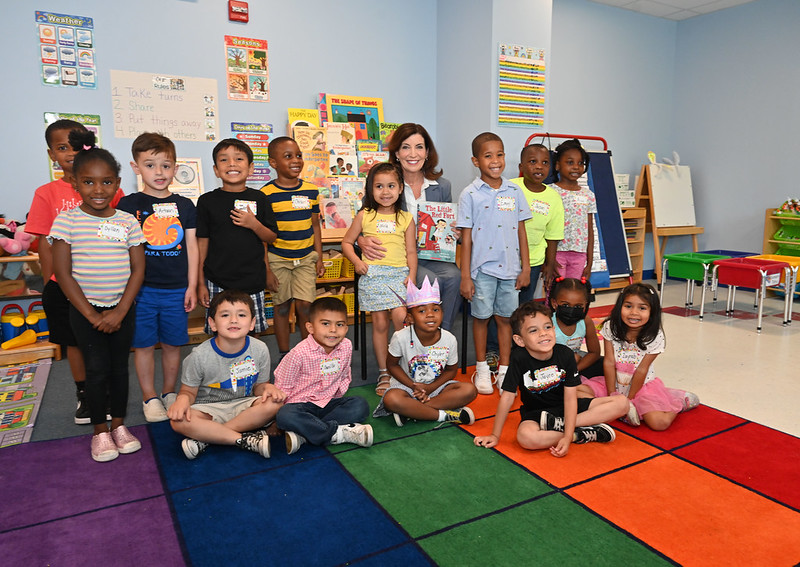
Gov. Hochul makes a school visit (photo: Kevin P. Coughlin/Governor's Office)
According to Advocates for Children of New York, over 104,000 children were homeless during the 2021-2022 school year. For the seventh year in a row, 10% of kids are experiencing homelessness in New York City. There are many causes of homelessness, but one of the most common is domestic violence. Parents who are in abusive relationships often have limited access to money, nowhere to go, and no family or friends to turn to, and when they become homeless, so do their kids.
There are lifelong implications for children who witness or experience domestic violence. These children are 50% more likely to become victims or perpetrators of violence themselves. They are also more likely to engage in high-risk behaviors and struggle with depression and anxiety.
Connecting children experiencing homelessness with trained social workers is one of the most effective methods of helping them heal from trauma and preventing future violence. But very few have access to the resources they need. New York should invest in programs that provide youth living in shelters with access to trauma-centered supportive services.
Social workers can offer one-on-one counseling to students, helping children acknowledge their trauma, grow healthy relationships, and have successful academic careers. Because their personal lives are often unstable, homeless children struggle in school, graduate at lower rates, and drop out at higher rates.
Statistically, most homeless families are headed by single women of color who are left with few options and limited resources to help their children. They may be juggling full-time work or searching for employment with securing housing and transporting their children to and from school; these challenges are compounded by the psychological damage of domestic violence. This group of women is more likely to experience mental health disorders, post-traumatic stress, and drug addiction as a result of these factors. Children in these families don’t have access to the support systems needed to succeed in school or break the cycles of violence and poverty.
The AAP has called for expanded access to school- and community-based supports to provide at-risk youth with the tools they need to develop healthy coping skills and relationships. Reaching homeless children, who are in danger of slipping through the system’s cracks, and providing them with services must be a priority for the state.
Urban Resource Institute (URI) is trying to reach those children.
URI administers the school-based Relationship Abuse Prevention Program (RAPP) and Early RAPP to help approximately 40,000 middle and high school students each year to develop healthy relationships within their families, schools, and communities. The culturally sensitive, age-appropriate and trauma-informed programs include conflict resolution and problem solving, with a focus on overcoming trauma, anxiety, and depression. The program is run by trained social workers who provide individualized support and is supplemented by peer counselors within each participating school.
URI’s RAPP program has changed the trajectory of many young people's lives — and their families and communities — by providing them with the tools they need to define and develop healthy relationships with the support of peers and educators who share their concerns and understand their needs. Future domestic abuse is avoided, and cycles of violence are broken.
URI is the nation’s largest provider of domestic violence shelter services and a leading provider of services for homeless families, accommodating as many as 2,200 people every night in its domestic violence and homeless shelters. Sadly, children and youth make up an average of 70% of the total URI shelter population. Though many young people in shelters have been impacted by domestic violence, the majority do not have access to RAPP programming as it is only available in a limited number of schools.
Expanding these programs to reach students living in domestic violence shelters is key for helping homeless families and their children. That’s why URI has requested $3.5 million in funding from the state to be included in the 2023 fiscal year budget, due by April 1, so that relationship abusive prevention programming can be offered to children in shelters.
We need New York State’s support to effectively scale programming and make a huge difference for the city’s growing population of homeless children. With their investment, we can transform the lives of domestic violence survivors, helping their children succeed in school and escape poverty.
***
Nathaniel M. Fields is the CEO of Urban Resource Institute (URI), the nation’s largest provider of residential domestic violence services as well as a leading provider of shelter and services for families experiencing homelessness. On Twitter @natmfields & @URI_NYC.
***
Have an op-ed idea or submission for Gotham Gazette? Email This email address is being protected from spambots. You need JavaScript enabled to view it.
A Crucial Moment for New York City’s Mental Health Crisis Response Program
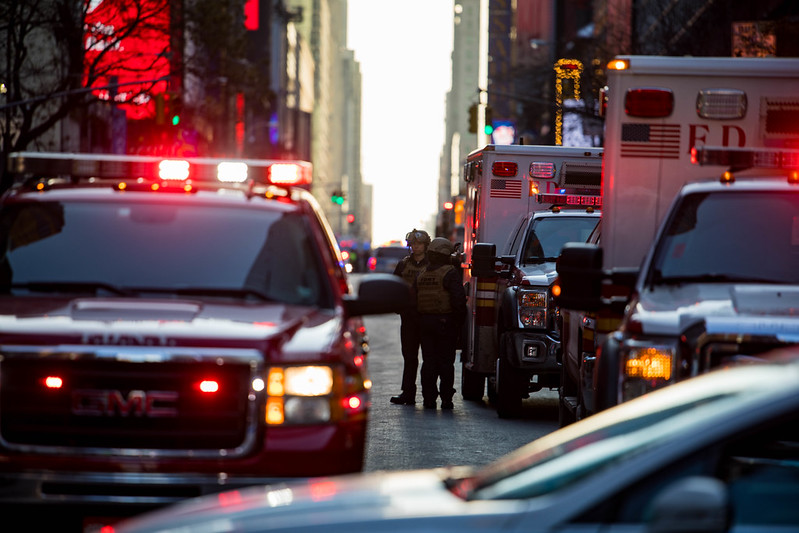
Emergency response (photo: Benjamin Kanter/Mayoral Photo Office)
The Behavioral Health Emergency Assistance Response Division (B-HEARD), New York City’s attempt to reform the way 911 responds to mental health emergencies, has been operating in select neighborhoods for more than a year. And trends are heading in the wrong direction.
B-HEARD launched in June 2021 as an alternative to NYPD-led response to mental health-related 911 calls, which can often turn deadly. Instead, B-HEARD teams consist of paramedics and social workers to handle these crises. In the 12-month period that ended on June 30, there were about 11,000 mental health calls to 911 in the areas served by the program, which initially covered five police precincts in Harlem and now includes 11 precincts in Manhattan and the Bronx.
But as the program expands, we need to address its declining efficacy. Correct Crisis Intervention Today in New York City (CCIT-NYC)’s recent analysis of data that the city quietly released last month shows increased response times and hospitalizations, and fewer responses to mental health-related calls. To make matters worse, police officers are responding to B-HEARD calls, which defeats its intended purpose of serving as an alternative to police-led response.
It doesn’t have to be this way.
New York could learn from Portland, Oregon. Its Portland Street Response (PSR), which I had the good fortune of visiting earlier this year, is nearly identical to B-HEARD and was launched just a few short months earlier. While these programs are designed to operate in similar ways, PSR’s recent 12-month data shows it has had greater success in terms of total hospitalizations, number of responses to mental health-related calls, and average response times.
Last March, the Portland program expanded to become citywide. Since its expansion, the program is taking a record number of calls — from 44 in the month of October 2021 to 824 in October 2022, a 1773% increase. B-HEARD, meanwhile, is responding to fewer and fewer. Throughout the year in New York, 911 routed just 22% of mental health calls to B-HEARD’s pilot program, and B-HEARD teams responded to 69% of those calls — down from 82% at the pilot’s start.
Both PSR and B-HEARD include paramedics and mental health professionals in their response teams. But there is a pivotal difference between the two programs: PSR also includes two trained peer specialists to be responders.
As someone who experienced a mental health crisis and later was trained to assist others at Howie the Harp Advocacy Center in New York City, I know that peers offer an empathetic response that cannot be replicated by those who have not been through the same experiences. Peers are trained to de-escalate crises and connect individuals with the services they need for future support. They are also part of the follow-up process to ensure individuals continue to receive the help they need so a dangerous situation does not arise again. They are crucial to the success of a program.
In addition to the inclusion of peers, Portland also makes more data available to the public. PSR publishes a dashboard that is routinely updated with call volume and location of calls routed to PSR. Its first-year evaluation was a 144-page document outlining the program’s performance and outcomes, as well as general stakeholder feedback.
New York, by comparison, published just a two-page data brief that included year-long averages rather than quarterly numbers. Nowhere can New Yorkers find data as granular as that in Portland, which highlights prominent hours, days, and locations of the calls routed to PSR. New Yorkers deserve to know what is happening in their communities. And without access to this data, it is impossible to gauge whether a program is successful.
PSR plans to become a 24/7 service within the next year. I want the same for B-HEARD, which currently operates 16 hours a day. But I am wary of potential expansion of a program that needs serious revisions. Members of the New York City Council have indicated that they are ready to hold a joint oversight hearing. We call on Eva Wong, the Director of the city’s Office of Community Mental Health, to testify. There's no time to waste.
***
Evelyn Graham Nyaasi is Advocacy Specialist at Community Access, a member of the CCIT-NYC Steering Committee, and identifies as a peer (a person with lived experience with mental health recovery and services). On Twitter @ccitnyc.
***
Have an op-ed idea or submission for Gotham Gazette? Email This email address is being protected from spambots. You need JavaScript enabled to view it.
Who’s To Blame for Our NYC Teacher Health Care Debacle?

Then-Mayor de Blasio speaks to the UFT (photo: Ed Reed/Mayoral Photography Office)
A long-time UFT chapter leader I know used to joke, “There are two things wrong with our union—the leadership and the membership.” I’ve been very involved with the teachers union, both in opposition and alongside leadership, and I couldn’t agree more. That two-pronged problem with our union is evident in the saga over major changes to health care for retired and current teachers.
Let’s look first at membership. In 2018, 86% of us voted yes on a contract. I was on the UFT Contract Committee and fully supported it. It wasn't a great contract, but it appeared to be a fair one. Depending on who you asked, it was above or close to cost of living, and there were no horrendous givebacks. At least that’s what we were told.
The contract was very quickly presented to the UFT Executive Board and Delegate Assembly. I voted yes in both bodies. It then went to membership where, as everyone expected, it was voted up by an overwhelming majority. Everything seemed fine.
Now, in 2022, we’re looking at a rollback of benefits for retirees. This, evidently, is because of a side agreement leadership made with the city in our 2018 contract. The UFT promised health care savings in Appendix B of our Collective Bargaining Agreement. However, this agreement was not presented to the Contract Committee, the Executive Board, the Delegate Assembly, or rank and file. We only found out about it after the contract was ratified.
A large problem with membership is we tend to view UFT as an outside entity. Why did the UFT do this or that? Actually, we are the UFT. But in terms of union action, we don’t do much other than wear a particular color every once in a while.
The more pressing problem with membership is that we trust leadership. We now know they withheld the health care deal expressly to mislead us, so we ought not to have done that.
I was pretty surprised when we were told the default for retirees would now be a Medicare Advantage plan. My mind went straight to Joe Namath on TV hawking Advantage as though it’s the new aluminum siding. Get it now, quickly, before time runs out!
But union president Micheal Mulgrew told us this was a new kind of Advantage. It wouldn’t be like the Namath plan. Every doctor who accepted Medicare was going to take it. At first, I was willing to give it a try if I retired anytime soon.
But then members started asking doctors whether they accepted this plan, and doctors answered no, they did not. Health care for city workers is negotiated by the Municipal Labor Committee, an umbrella group of city unions (not all of whom support these changes). Evidently, the MLC, before announcing this plan, had not even bothered to enlist doctors to participate.
Any retiree who wanted to stay in standard Medicare would have to pony up $191 per person per month, almost $5,000 a year for a couple. That’s a considerable expense for people trying to get by on a pension. I started hearing complaints from people I’d never known to complain before.
Another thing MLC failed to do was check current regulations. The city was precluded from charging people to enact this program. MLC, UFT included, lobbied to change Administrative Code 12-126 along with Mayor Eric Adams.
Given these blunders, and given the health care agreement was born of blatant deceit, it’s a wonder anyone trusts MLC or UFT leadership on health care, or anything whatsoever.
We recently received an email from Mulgrew suggesting that, if the law were not changed, in-service members might have to pay $1,500 a year to retain health care. This put forth a zero-sum game, pitting in-service members against retired ones. This notion is antithetical to that of union.
Why is Michael Mulgrew working so hard to help various mayors, our actual adversaries in collective bargaining, to save money at the expense of membership? That’s likely because the health care agreements (which union leadership had kept secret until after we’d voted up the contract) continue after our contract expires, which indeed it has. In this outlandish one-sided agreement, our health care continues to be cut, but the city is not obliged to give us a dime in compensation increases.
It’s beyond disheartening to learn what a miserable job our negotiators did for us in 2018. All our hours on the Contract Committee were wasted, since leadership made a counter-productive deal behind our back. They sacrificed our health care to win only modest gains. Our Contract Committee is a sham, UFT has the worst negotiating team in the world, and every member of that team should be impeached or fired.
Now the union is trying to bargain a new contract with Eric Adams, and Adams says health care savings must be taken care of beforehand. Michael Mulgrew tells us to wear blue one day. Call me cynical, but I don’t see how that frightens Adams.
UFT rank and file absolutely did not approve of these health savings. As far as I’m concerned, they ought to come directly out of the pockets of those who made the agreements.
They fooled me once, but it won’t happen again. Hopefully my union brothers and sisters aren’t fooled anymore either.
Correction: There was a health agreement made by MLC six months before the 2018 Contract, and UFT members were informed if it. Rank and file had not voted on it, and we were not aware of the particulars or implications. It was incorporated into Appendix B of the contract, which was not shared with us before the contract was ratified.
***
Arthur Goldstein is an ESL teacher at Francis Lewis High School, and a former UFT executive committee member. On Twitter @TeacherArthurG.
***
Have an op-ed idea or submission for Gotham Gazette? Email This email address is being protected from spambots. You need JavaScript enabled to view it.
Victorious, Now Governor Hochul Needs to Lead on Climate
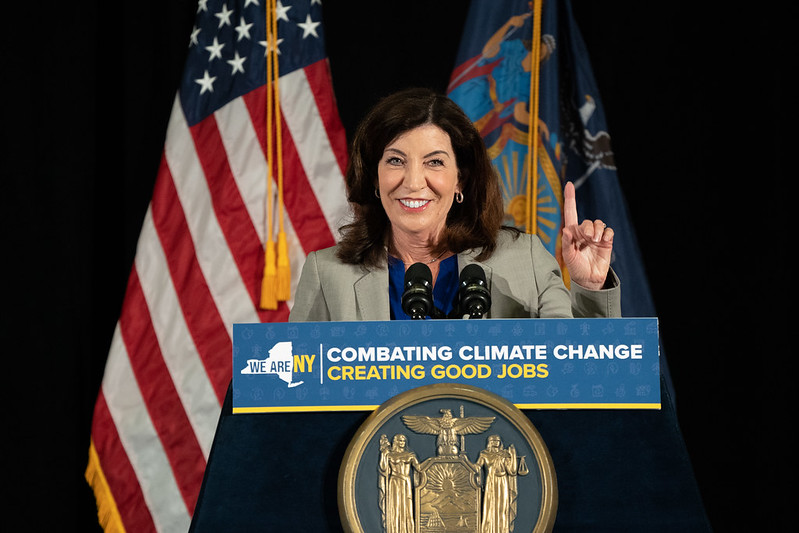
Gov. Hochul makes a green jobs announcement (photo: Governor's Office)
Governor Kathy Hochul won election in a low turnout race thanks to progressive activists, elected officials, and organizations who showed up to get out the vote. Now it’s time for her to deliver on her campaign’s climate promises and pass the Climate, Jobs and Justice legislative package.
It has been three years since New York passed its landmark climate law, the Climate Leadership and Community Protection Act. In that time, the state has failed to live up to its climate commitments, and crucial climate legislation has stalled in the Assembly, year after year. Even now, Governor Hochul still has not signed one of the few climate bills that did pass in the 2022 session, a bill to enact a two-year moratorium on new fossil-fuel-plant cryptocurrency mining in New York.
Meanwhile, the climate crisis has continued to hurt communities across the state through hurricanes, deadly heat waves, and flooding. Just two days before Election Day, temperatures neared 80 degrees in New York City. And this year’s IPCC report sounded the alarm that it is “now or never” for climate action, calling for rapid and immediate cuts to global greenhouse gas emissions to prevent climate catastrophe.
New Yorkers understand how important climate action is, and Governor Hochul has promised she does as well. Ten years after Hurricane Sandy devastated much of the state, the $4.2 billion Environmental Bond Act, which would fund some climate mitigation projects and the governor and Legislature thankfully put on the ballot, earned hundreds of thousands more votes than Hochul herself. Statewide, a sizable 60% of voters voted yes on the proposal, and in New York City, a whopping 81% approved the measure.
But the funding that comes with the passage of the Environmental Bond Act is just a start, and we need Hochul and the State Legislature to take the next step. The Climate, Jobs and Justice Package would fully implement the CLCPA and enact a series of legislative priorities like the Build Public Renewables Act to transition our electrical grid to renewables. The package would also hold corporate polluters accountable by ending fossil fuel subsidies and taxing the wealthy to fund the necessary transitions mandated by the CLCPA.
The election made clear that New Yorkers want climate leadership. The reason I and many other activists joined the Working Families Party to volunteer for Hochul is because we know how urgently New York needs to enact climate justice and she was the better choice to lead on climate. Governor Hochul must ensure the 2023 legislative session fulfills the promises of the CLCPA and puts our state on track for a just, livable future.
***
Liat Olenick is an activist and teacher in Brooklyn. On Twitter @Liat_RO.
***
Have an op-ed idea or submission for Gotham Gazette? Email This email address is being protected from spambots. You need JavaScript enabled to view it.
With the Environmental Bond Act’s Passage, Let’s Ensure the Green Transition Creates Good Jobs
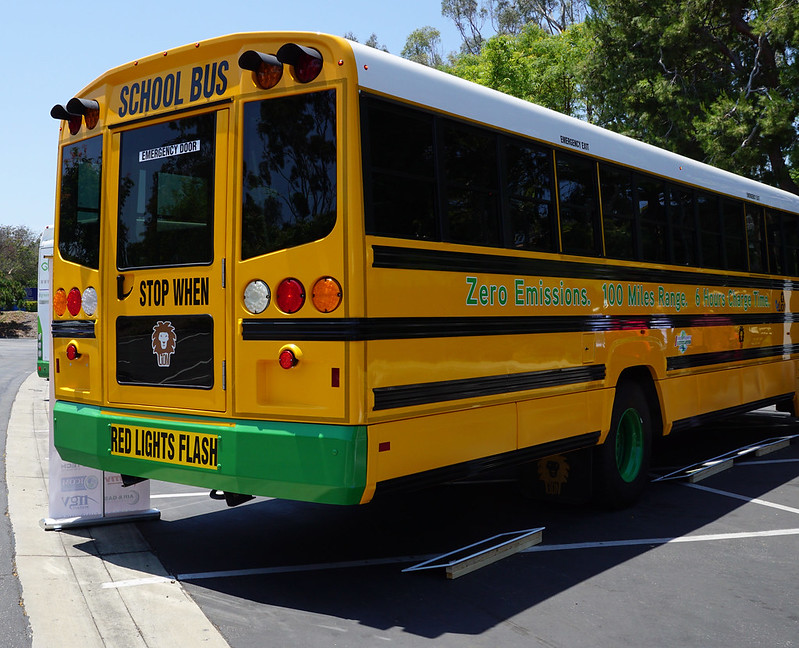
Green school buses on the way (photo: Caitlin Looby)
This past week New Yorkers went to the polls and voted for justice. With passage of the $4.2 billion Environmental Bond Act we now have the opportunity to move with resources, resolve, relief, and hope in tackling some of the most pressing issues of our time.
We look forward to the swift and diligent implementation of the bond act, including ensuring the electric school bus purchasing process creates high-quality community-sustaining jobs through the usage of incentives that encourage manufacturers to commit to good wages, benefits, and training. Labor, climate, and community groups are enthusiastic about the progress awaiting our state and ready to support the process.
In April, Governor Hochul and the State Legislature advanced the Clean Water, Clean Air and Green Jobs Environmental Bond Act of 2022 to appear as a ballot initiative. Now passed by voters by a wide margin, this measure will be a significant step in addressing the climate crisis, making our economy more equitable, and advancing New York State’s climate and economic justice priorities.
There are four major focus areas in this legislation, including climate change mitigation. A key component of this is ensuring at least $500 million for zero-emission school bus purchases and conversions and building supporting infrastructure. This will make for cleaner air in our communities and contribute to a reduction in global warming, while creating green jobs.
My organization, Jobs to Move America, has spoken with unionized workers who manufacture school buses that are starting to transition to electric. One told us he is excited about the transition and would love to see all of his company’s school bus models go electric. Another said that he is very happy knowing that the buses he manufactures will benefit his grandkid's generation and generations to come. They're excited because their work will positively impact the future of our communities. They're also excited because their union gives them job security and the training they need to manufacture electric school buses.
New York is primed to lead in climate and labor justice to remedy the pitfalls we presently face and safeguard the future of our communities. There is no second option. There is no other time. If we didn’t recognize this earlier, the pandemic has blatantly underscored how vulnerable our environment, economy, and health are. With passage of the Environmental Bond Act, we took a milestone leap towards ensuring all workers – manufacturers, mechanics, drivers, and more – benefit from the green transition and that the electric school bus industry is developed equitably to create good green jobs.
We have known and suffered the adverse effects of greenhouse gas emissions for generations. Diesel emissions have been harming our planet, children, and workers – especially school bus drivers and mechanics – for decades. The long overdue transition to 450,000+ electric school buses will be an essential step towards protecting the health and well-being of our communities, our planet, and our future. With zero tailpipe emissions and 70% less greenhouse gas emissions than diesel buses, they are the cleanest alternative available.
Committing to an all-electric school bus fleet, as New York has done, creates the opportunity to be a world leader in the transition away from fossil fuels. We can set an example for other states of sustainable development and how it benefits people, particularly children and workers.
Electrification represents a massive shift in the vehicle manufacturing industry, presenting character and future defining choices for our state. The implementation of the Environmental Bond Act in New York is an opportunity for us to end the pattern of job losses during industry transition, and choose to transform in a way that creates high quality community-supporting jobs.
This investment has the capacity to be remedial, protective, and preventive. The past two years have been a bellowing wakeup call for us to recognize how one unexpected calamity can upend our lives and throw everything off center. It is imperative for us to urgently implement an equitable transition into electric school buses to counter the climate and economic crises, and tap into the transformative potential of using government procurement for public good.
***
Farah Mehreen Ahmad is the New York Senior Organizer at Jobs to Move America, as well as a writer, translator, and interpreter. On Twitter @JobsMoveAmerica.
***
Have an op-ed idea or submission for Gotham Gazette? Email This email address is being protected from spambots. You need JavaScript enabled to view it.
The Affordable Care Act Just Turned 10; It’s Important to Take Stock of Its Positive Impact
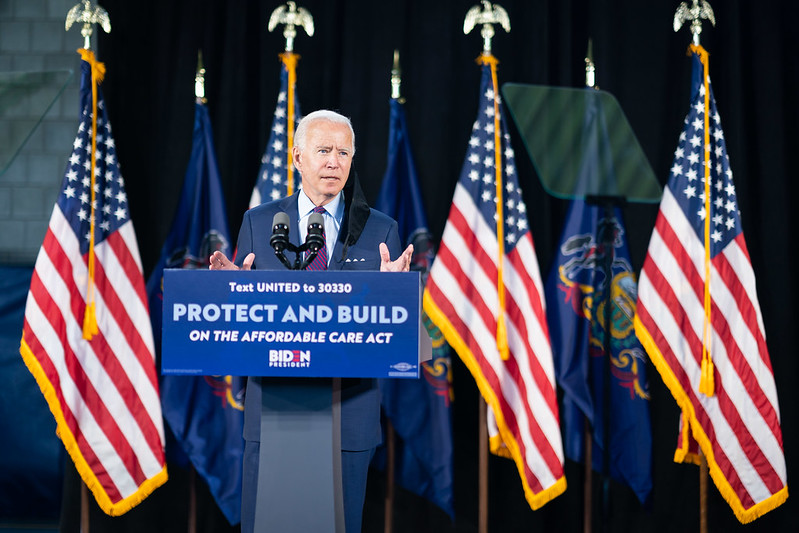
Joe Biden talks ACA (photo: Adam Schultz/Biden for President)
Rewind the clock ten years, and you’ll find a much unhealthier America with significantly less access to quality, affordable healthcare. What do pregnancy, seasonal allergies, and diabetes have in common? Besides all being physical traits, up until ten years ago these were grounds for insurers to charge a higher monthly premium or deny coverage altogether. Premiums were high, coverage was paltry, and 60 million Americans were forgoing insurance altogether.
The picture this paints is a bleak one, but in November 2012 the Affordable Care Act – also known as Obamacare – came into effect and proved to be literally life-changing for millions of Americans, from low-income people to those with pre-existing conditions to those under the age of 26.
As we celebrate the ACA turning ten, it’s important to reflect on the sea change this landmark legislation had on how Americans get their healthcare, how frequently they rely on healthcare, and how expensive and how selective health insurers were when it came to who got healthcare and who did not.
Ten years later, there is much to be celebrated. And even as the Biden Administration makes strides in fortifying the ACA, it is apparent that more work is yet to be done.
So how has the ACA benefited the average American? For starters, prior to the enactment of the ACA, some 54 million Americans, or 27% of the U.S. population, had “declinable” pre-existing conditions, meaning they were “uninsurable” (other estimates put this number at 133 million). Virtually any medical condition that was known to the individual prior to applying for healthcare was considered a pre-existing condition, whether it was as benign as acne or as malignant as chronic heart disease. The discrimination health insurers levied against these individuals caused the average premium to skyrocket and left much of the country without any insurance whatsoever.
The ACA didn’t stop with banning such discrimination based on pre-existing conditions. Thanks to the law, all insurance plans have since been required to adequately cover the ten “Essential Benefits.” These benefits range from emergency care to pregnancy to prescription drugs, comprehensively ensuring that no American is forced to go without these services or pay a higher premium for them. The anxiety – now covered under wellness services and behavioral health treatment, both essential benefits – that Americans faced when deciding whether they could afford healthcare has since dissipated significantly.
Affordability is likewise tantamount to a larger share of Americans being enrolled in a healthcare plan. Soaring premiums a decade ago were a barrier for many who simply could not afford to be insured; today, roughly 13 million Americans receive subsidies in the form of tax credits that keep their healthcare within their means.
President Biden has kept the momentum going. While certain subsidies were set to expire in 2022, a three-year extension was passed earlier this year to the relief of millions of Americans, who are set to continue saving approximately $800 per month in insurance premiums.
The budget for navigators is also getting a boost. Navigators help Americans maneuver through the enrollment process, explaining the differences between plans and finding the right plan for everyone. Funding for navigators was drastically cut under President Trump, but is set to jump 24% this year from last.
And as the momentum to strengthen the ACA persists, the popularity of the landmark legislation continues to underscore the importance of a more affordable, quality healthcare system. Sign-ups last year reached an all-time high of 14.5 million Americans and is on track to meet or even surpass that figure for 2023. If the trends continue, there will be a steady decrease in the number of Americans forgoing health insurance altogether.
This is all good news for the Biden Administration, which has made the ACA a key focus of its agenda, and for the Americans who benefit from it. Yet the dichotomy between the popularity of the ACA and the perception of our healthcare system overall indicates that much is left to be desired and more work must be done. A majority – 55% – approved of the ACA in 2022. This is a stark contrast from the 44% of Americans who gave the overall healthcare system a D or F grade this year; a whopping 75% of Americans also gave healthcare affordability a D or F.
These numbers don’t exist in a vacuum. While the concept of the ACA is highly popular, in reality the approximate $456 average for monthly premiums next year is still enough to turn people away from enrolling in a plan, especially when that’s a slight increase over the average cost last year. The fact that the ACA has drastically cut healthcare costs for Americans gets overlooked when premiums remain a financial obstacle for much of the country. However, if the popularity of the ACA retains a majority of Americans’ votes, it’s clear that many are cognizant of how much worse off they could be without the law.
The momentum can’t stop here. There is no reason a nation with the level of prosperity enjoyed in the U.S. should have a healthcare system that many Americans can’t afford. More must be done to continue to work towards the goal of enrolling every American who lacks a healthcare plan.
But it is undeniable that the Affordable Care Act has left a largely positive, lasting imprint on the country. In the decade since the first enrollment season, America has become more insured, more affordable, and should President Biden and his predecessor have their way, will continue to trend in the right direction. For now, let’s celebrate this milestone and toast to the next ten years.
***
Colin Wolfgang is a political and communications consultant. On Twitter @ColinWolfgang.
***
Have an op-ed idea or submission for Gotham Gazette? Email This email address is being protected from spambots. You need JavaScript enabled to view it.
Creating Career Pathways for Veterans in New York City Government
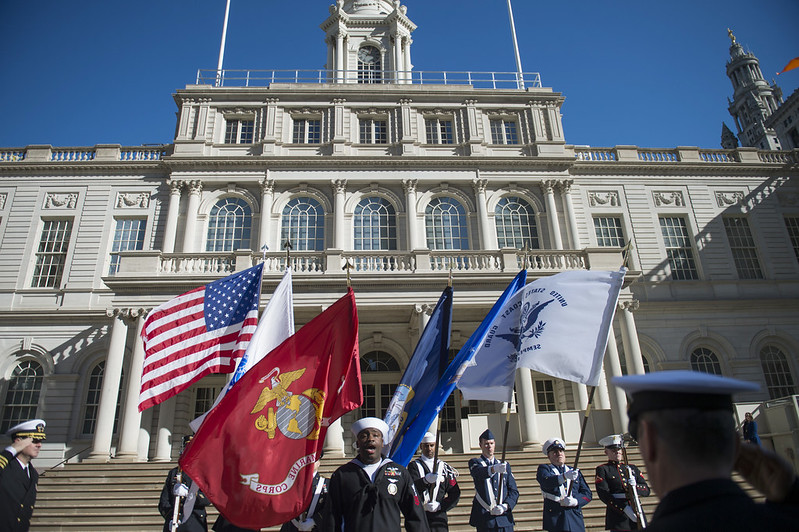
Veterans Day at City Hall (photo: Ed Reed/Mayoral Photography Office)
Democracy is an ideal that is central to who we are as Americans, but it’s an ideal that must be advanced and defended by each generation. While we are fortunate to have the freedom to choose our elected leaders and have a voice in our government, this freedom has been secured and defended by our military veterans. Their willingness to serve and sacrifice represents the highest calling in public service, and we owe these heroes an enormous debt of gratitude.
Over a quarter million veterans live in New York City and each has contributed to the peace and security we all enjoy. This Veterans Day, we express our sincerest thanks for their contributions. We thank them for being public servants and for answering the call of duty.
One small way the City of New York is acknowledging the service of our veterans is by creating career pathways for them to continue their service in city government. DCAS — the New York City Department of Citywide Administrative Services — offers fee waivers on civil service exams so that eligible veterans can take exams free of charge. To account for their unique skills and experience, veterans can also earn bonus points on those exams. Now, to further say thanks to our veterans and military families, we will be extending fee waivers for one exam to spouses of veterans.
At DCAS, public service is central to our mission. We manage the civil service system, the gateway to careers with the City of New York. As the largest local government employer in America, the career opportunities we offer to New Yorkers through civil service hiring helps us marry an individual’s interests with their passion for public service. Through the civil service system, applicants are afforded opportunities to demonstrate their fitness for jobs based on an objective assessment of their knowledge, skills, and abilities.
It is among our chief responsibilities to ensure that our civil service process develops a steady stream of qualified candidates who are ready to serve their city. When we think about the caliber of talent we need to lead our agencies, contribute to our city’s growth, and play a role in planning the future, there are few as worthy as our veterans. So, this Veterans Day as we celebrate their achievements and their sacrifice, we invite them to answer the call to service again – serving the City of New York. Our civil service pathways provide a wealth of career options, opportunities for advancement, and great benefits.
An effective government hinges upon having a workforce that is passionate about serving others. Our veterans embody this commitment, and we want to create pathways for veterans to join our ranks and make a difference in our city.
To learn more about upcoming civil service exams and careers with the City of New York, visit nyc.gov/dcas and nyc.gov/jobs.
***
Dawn M. Pinnock is the Commissioner of the NYC Department of Citywide Administrative Services (DCAS). On Twitter @NYCDCAS.
***
Have an op-ed idea or submission for Gotham Gazette? Email This email address is being protected from spambots. You need JavaScript enabled to view it.




